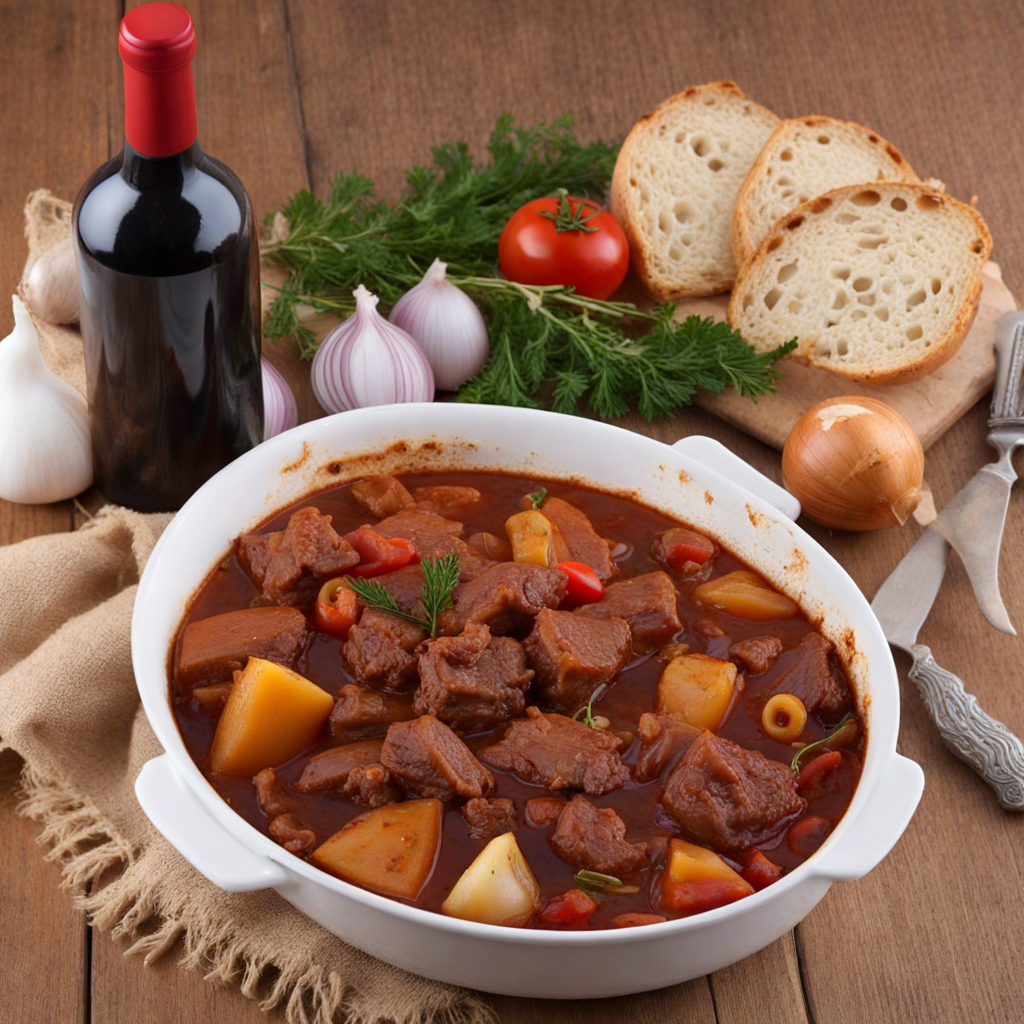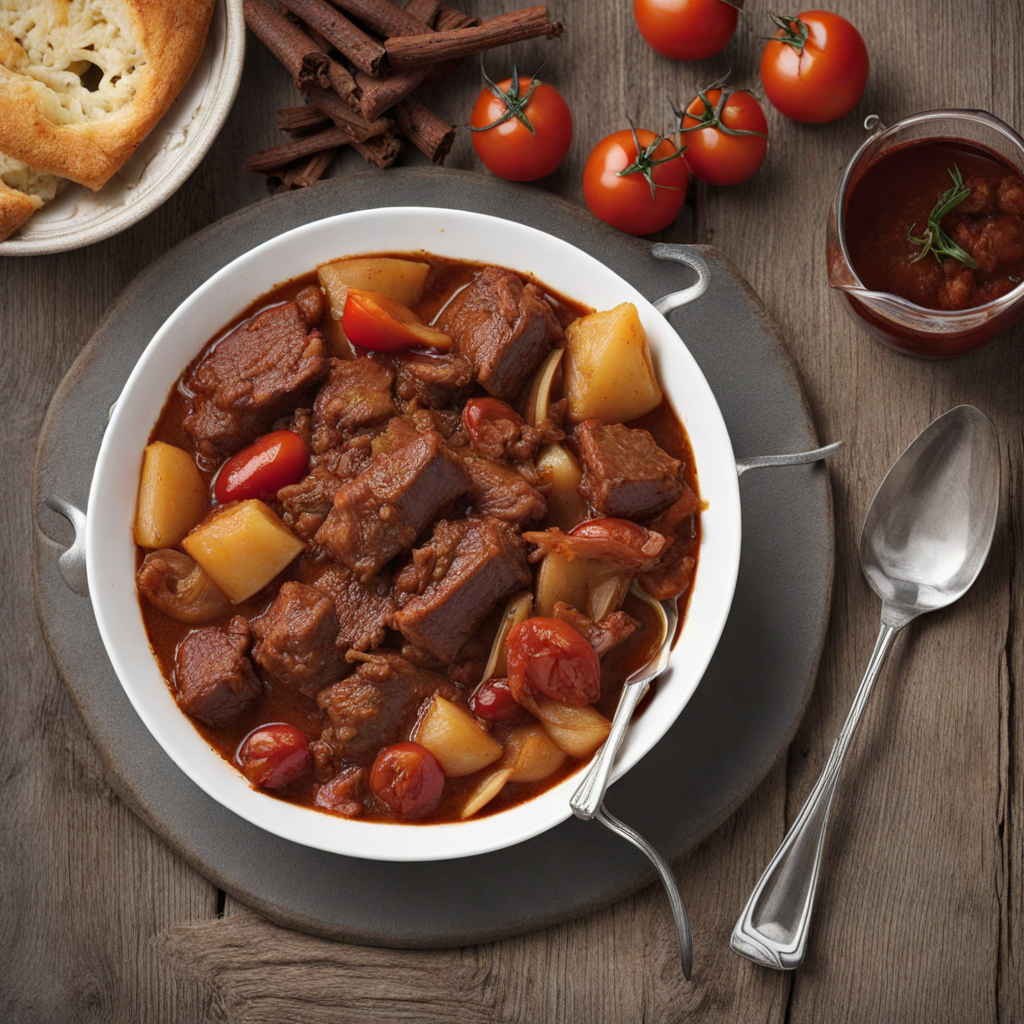Stifado
Stifado is a traditional Greek stew that captivates the senses with its rich and aromatic flavors. The dish is primarily made with tender pieces of meat, typically beef or rabbit, slowly simmered to perfection with an array of spices and ingredients. What sets Stifado apart is its unique blend of cinnamon, cloves, and allspice, which infuses the meat with a warm, slightly sweet, and fragrant profile, making each bite a delightful experience. The addition of pearl onions adds a touch of sweetness and a pop of texture, while ripe tomatoes contribute to a luscious, saucy base that envelops the meat in a comforting embrace. As you savor Stifado, you’ll also notice the presence of red wine, which not only deepens the flavor but also tenderizes the meat, creating a harmonious balance between acidity and richness. This dish is often served alongside rustic bread or over a bed of fluffy rice or creamy mashed potatoes, allowing you to soak up every last drop of the tantalizing sauce. Each element of Stifado works together to create an unforgettable taste experience that reflects the heart of Greek home cooking. Stifado is more than just a meal; it’s a dish that brings people together, often enjoyed during family gatherings or festive occasions. The slow-cooking method allows the flavors to meld beautifully, making it a perfect dish for preparing in advance and serving at gatherings. Whether you’re sitting down for a cozy dinner or celebrating with loved ones, Stifado promises to warm your heart and tantalize your palate, offering a taste of Greece that is both comforting and exotic.
How It Became This Dish
The History of Στιφάδο: A Culinary Gem of Greece Introduction Στιφάδο (stifádo) is a traditional Greek stew that embodies the rich tapestry of flavors, ingredients, and cultural narratives that define Greek cuisine. This dish, characterized by its slow-cooked meat, aromatic spices, and sweet undertones from onions and tomatoes, has a history that stretches back through centuries, reflecting the diverse influences that have shaped Greek gastronomy. Origins: A Mediterranean Mosaic The origins of stifádo can be traced back to the Byzantine era, a time when culinary practices were heavily influenced by various cultures throughout the Mediterranean. The term “stifádo” itself is believed to derive from the Italian word “stufato,” meaning “stew,” which highlights the exchange of culinary traditions between these neighboring cultures. The Greeks and Italians have long shared culinary practices, particularly in the realm of stews and braised dishes. Historically, stifádo was made with various types of meat—most commonly beef or rabbit—paired with a generous amount of onions, often small pearl onions or shallots, and flavored with an array of spices, including cinnamon, allspice, and bay leaves. The dish typically includes tomatoes or tomato paste, which adds a vibrant, tangy sweetness that balances the spices. The use of vinegar or red wine is also customary, giving stifádo its signature depth of flavor. Cultural Significance Stifádo is more than just a dish; it is a symbol of Greek hospitality and the communal spirit imbued in Greek dining culture. Traditionally, it is served during family gatherings, festive occasions, and celebrations, embodying the warmth and generosity that characterize Greek culture. The slow-cooked nature of the dish allows for the flavors to meld and develop, making it perfect for sharing among family and friends. In many regions of Greece, stifádo has taken on local variations, showcasing the regional ingredients and flavors unique to each area. For instance, in the islands and coastal areas, seafood versions of stifádo have emerged, substituting the traditional meats with octopus or cuttlefish. This adaptability and regional diversity further enhance the dish's cultural significance, as it reflects the local customs, agricultural practices, and available resources. Development Over Time As Greece evolved through various historical phases—from the Byzantine Empire to Ottoman rule and into the modern era—so did stifádo. In the 19th century, Greece underwent significant social and political changes. The emergence of a national identity fostered a renewed interest in traditional Greek cuisine, and stifádo became emblematic of this culinary revival. During the Ottoman period, the exchange of spices and culinary techniques led to the incorporation of Eastern flavors into Greek cooking. This influence is evident in stifádo, where spices like cinnamon and allspice reflect a shared culinary heritage with Middle Eastern cuisines. The dish became commonplace in Greek households, celebrated for its affordability and ability to feed large families. In the 20th century, stifádo gained popularity beyond the home kitchen. As Greeks emigrated to other countries, they brought their culinary traditions with them. Stifádo found its way into Greek restaurants around the world, where it was often adapted to suit local tastes while maintaining its core essence. This globalization of the dish contributed to its recognition as a quintessential Greek meal. Modern Interpretations In contemporary Greek cuisine, stifádo continues to evolve, with chefs experimenting with ingredients and presentation while honoring its traditional roots. Modern interpretations often include creative twists, such as using exotic spices or incorporating seasonal vegetables. However, the heart of the dish remains the same: a celebration of slow cooking, rich flavors, and communal dining. In addition to its presence in restaurants, stifádo has also made its way into popular culture. It appears in cookbooks, food blogs, and television cooking shows, where chefs and home cooks alike share their personal recipes and stories. This modern visibility has helped to solidify stifádo as a beloved dish among both Greeks and those who appreciate Greek cuisine worldwide. Conclusion Stifádo is more than just a meal; it is a testament to Greece's rich culinary history and cultural heritage. From its origins in the Byzantine era to its place in modern Greek cuisine, this dish has traversed time and space, adapting to the influences of diverse cultures while retaining its core identity. Whether enjoyed at a family gathering, a festive celebration, or a local taverna, stifádo embodies the essence of Greek hospitality, making it a cherished culinary gem that continues to delight palates around the world. As the world continues to embrace global cuisine, stifádo stands as a reminder of the beauty of tradition and the power of food to connect people across generations and cultures. Its rich flavors and comforting essence are a reflection of the land, the people, and the stories that have shaped it, inviting all who partake to savor not just the dish, but the history and culture it represents.
You may like
Discover local flavors from Greece







